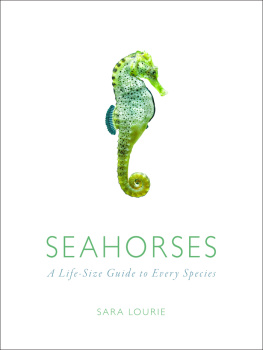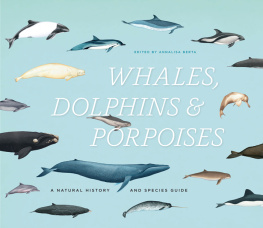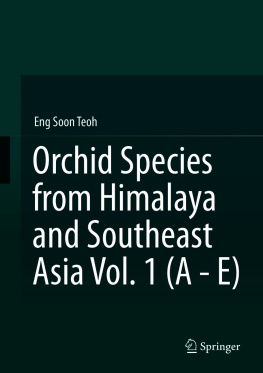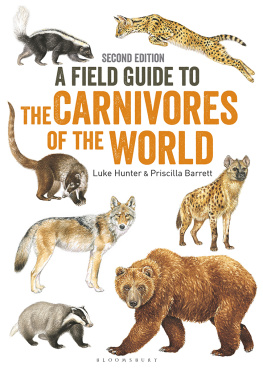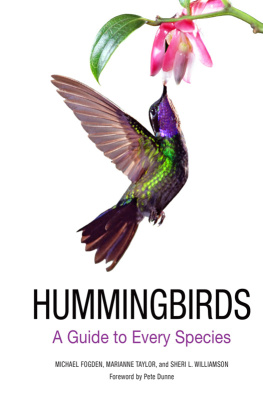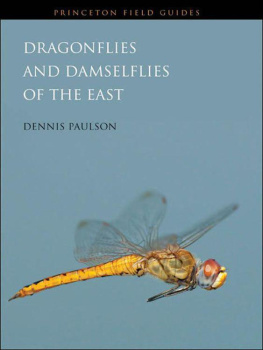SEAHORSES
A Life-Size Guide to Every Species

SARA LOURIE
THE UNIVERSITY OF CHICAGO PRESS
Chicago
Absolutely captivating creatures , seahorses seem like a product of myth and imagination rather than of nature. They are small, elusive, and are named for their heads, which are shaped like miniature ponies with tiny snouts. They swim slowly upright by rapidly fanning their delicate dorsal fin, coil their tails to anchor themselves against the current and spend days in a dancing courtship. Afterward, it is the male who carries the females eggs in his pouch and hatches the young. Seahorses are found worldwide, and they are highly sensitive to environmental destruction and disturbance, making them ideal flagship species for shallow-water habitat conservation. They are as ecologically important as they are beautiful.
In memory of Denise Tackett her love of seahorses and of the underwater world
Sara A. Lourie is a research associate with Project Seahorse. She has identified multiple new seahorse species and is the author of several books and articles on seahorse taxonomy.
The University of Chicago Press, Chicago 60637
2016 by The Ivy Press Limited
All rights reserved. Published 2016.
Printed in China
25 24 23 22 21 20 19 18 17 16 1 2 3 4 5
Text Sara Lourie 2016
Design and layout The Ivy Press Limited 2016
ISBN-13: 978-0-226-33841-5(cloth)
ISBN-13: 978-0-226-33855-2(e-book)
DOI: 10.7208/chicago/9780226338552.001.0001
Library of Congress Cataloging-in-Publication Data
Lourie, Sara A., author.
Seahorses : a life-size guide to every species / Sara Lourie.
pages cm
Includes bibliographical references and index.
ISBN 978-0-226-33841-5 (cloth : alkaline paper)
ISBN 978-0-226-33855-2 (e-book) 1.
Sea horses. I. Title.
QL638.S9L68 2016
597.6798dc23 2015035760
This book was conceived, designed, and produced by
Ivy Press
210 High Street, Lewes, East Sussex. BN7 2NS. United Kingdom
www.ivypress.co.uk
PUBLISHER Susan Kelly
CREATIVE DIRECTOR Michael Whitehead
EDITORIAL DIRECTOR Tom Kitch
ART DIRECTOR Wayne Blades
EDITOR Jamie Pumfrey
COMMISSIONING EDITOR Kate Shanahan
DESIGN JC Lanaway
PICTURE RESEARCH Alison Stevens
This paper meets the requirements of ANSI/NISO Z39.48-1992
(Permanence of Paper).

CONTENTS
INTRODUCING SEAHORSES

WHAT ARE SEAHORSES?
HORSES OF THE SEA
Seahorses are among the most charismatic marine creatures. They are so unlike typical fishes that they were once considered to be marine insects. With their upright posture, strange body-shape and features, and incredible camouflage, it is no wonder that people used to think that seahorses were mythological beings and assigned them such roles as bearing sea nymphs and pulling Poseidons chariot. The scientific name for the seahorse genus, Hippocampus (in this book shortened to H.), is derived from the Greek words hippo (meaning horse) and kampos (meaning sea monster).
Today we know that seahorses are in fact real fish, albeit most unusual ones, and that there are at least 40 different species. Like other fish, they have gills, fins, and a swim bladder. However, they swim vertically, propelled by a fin on their back, unlike typical fish, which swim horizontally and move by waving their tail fin. Seahorses lack scalesinstead their bodies are covered by skin stretched across bony plates. The junctions of these plates protrude into ridges, bumps, and spines, the form of which can help distinguish the different species. They have prehensile tails that can literally hold your hand (or at least your finger), and males possess a marsupial-like pouch within which the young develop. Their curious lobe-like gills resemble miniature bunches of grapes, and they have eyes that can move independently of one another, like those of chameleons. The seahorse snout is tubular, with a tiny toothless mouth at its tip, through which the animal sucks hapless prey (mostly small crustaceans) from the water column or off the surface of vegetation. Food passes through a short and simple gut that lacks even a differentiated stomach.
Perhaps one of the most remarkable things about seahorses is the fact that it is the male who bears the young. Female seahorses still produce the eggs, and the male produces the sperm. However, when the eggs are ripe, the female deposits them in the males brood pouch, and she plays no further role in the development of the young. The male, meanwhile, fertilizes the eggs inside his pouch, and undergoes an extensive pregnancy during which the young are nourished by the yolk-sac provided with each egg, bathed in a liquid that gradually changes from being like body fluids to resembling seawater over the course of a pregnancy. The seahorses grow until they are ready to be released into surrounding waters.
Seahorses are found in all tropical, subtropical, and temperate waters, meaning that extensive dispersal must have occurred over time, despite lacking a long planktonic dispersal phase. How that dispersal has been achieved may have something to do with the young grasping floating mats of vegetation with their prehensile tails, and rafting to far-off places. These secrets are starting to be unraveled as scientists begin to decode seahorse genetics.
As well as their strange shape and their unusual biology, seahorses are also highly prized for medicinal purposes, particularly in Asia. An estimated 1520 million seahorses are traded every year to satisfy the demand for traditional Chinese medicine. Live seahorses are also traded for aquaria, and dead (dried) ones sold as souvenirs. This exploitation rate, coupled with extensive trawling and destruction of their habitats has raised conservation alarm bells worldwide. Seahorses were among the first marine species to be listed by the Convention on the International Trade in Endangered Species (CITES). Many countries have national laws that help protect them, and volunteer divers in a number of countries have been recruited to help collect information on seahorse populations in the hope that this information and heightened awareness of the plight of these creatures will help save them.
It is becoming increasingly clear that the world beneath the waves (more than 70 percent of the Earths surface) is suffering hugely from overexploitation, habitat destruction, pollution, and climate change. We can no longer claim complete ignorance of what is going on, and continuing with the status quo will only lead down a path of further destruction and disruption of the biosphere. However, if we can mobilize efforts to save the charismatic seahorseand who doesnt love seahorses?it would go a long way toward addressing many of the issues that are causing problems in coastal areas of the worlds oceans.
SYNGNATHID EVOLUTION

Hypothesis of evolutionary relationships among a selection of Syngnathids. Based on work by Hamilton, Wilson, Teske and others. Note that the precise arrangement of taxa is uncertain in some cases, and that precise dates of divergence between taxa are not well known. Dark green lines show relationships or times that are better supported than light green lines. Dotted lines show approximate dates of divergence or fossil ages.
Next page
